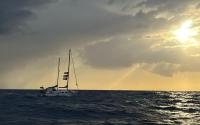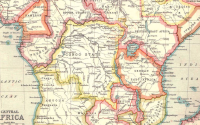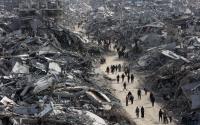24 July 2006
The old Soviet lighthouse on the edge of Pitlun lagoon is the best place to see one of the rarest whales in the world. From the rusting metal balcony at the top, there's a fine view over the only known feeding ground of the critically endangered western north Pacific gray whale - and at this time of year they are easy to spot as they feed in seas thick with marine life.
With so many congregating here in the summer months, it is easy to forget that this species is teetering on the very brink of extinction. But there are only about 100 western grays left alive, and the death here of just one female a year for the next three years would be enough to send the population into catastrophic decline.
It's not only whales that can be seen from the top of the lighthouse. Further out to sea, a vast drilling platform is extracting oil, a second is being constructed, and some of the largest ships in the world are laying hundreds of kilometres of new pipelines. The whales' feeding ground lies directly above huge reserves of gas and oil, which some of the biggest companies in the world are determined to exploit.
This small stretch of water off Sakhalin island, in the far east of Russia, has become the battleground for a struggle between environmentalists determined to save these whales from extinction and oilmen equally determined to push ahead with what one of them calls "the mother of all projects".
As the leaders of the G8 countries headed home from St Petersburg last week, after intensive discussions about energy security and the contribution that Russia's reserves can make to the global economy, they would have done well to cast their eyes 8,000km to the east. What is happening here will set precedents for other gas and oil projects in remote wilderness areas, raising troubling and pressing questions about how we square our thirst for energy with the irreversible impact it can have on the environment. On Sakhalin, that choice is an unusually stark one: extraction or extinction?
Our inflatable boat skims across an unusually calm sea, under a cloudless sky. The early morning sun is a welcome sight after days of thick fog. On the spit that separates Pitlun lagoon from the ocean, larga seals are basking on the beach while a pair of huge Steller's sea eagles wheel overhead.
At the mouth of the lagoon, we see the first blow - the plume of water a whale shoots into the air when it surfaces to breathe. We turn towards it, cut the engine and drift across with the current. It's a large female, about 12 metres long and probably more than 30 tons in weight. She swims on the surface for a few minutes, blowing spurts of spray high into the air, arching out of the water.
Western grays are the most strikingly marked of any whale species: barnacles, parasites, pigmentation and even scars from orcas - their only known predator - leave distinct patterns on their rough skin. This one is mottled with light-coloured barnacles across its back. It slips under the water for another dive.
The journey here is long and hard: a 13-hour flight from London, 15 hours by train, and then six bouncing hours in the back of a truck, the only vehicle robust enough to deal with the island's rough tracks and deep river-crossings. Geographically, we're closer here to Washington DC than to Moscow, and Japan is just 40km from the southern tip of the island.
Sakhalin has always been a wild and remote place. Many of the island's 900,000 inhabitants are descended from the thousands of convicts and political prisoners sent here between 1869 and 1906, when it was a Russian penal colony. When Anton Chekhov visited the island in 1893, he was appalled. Sakhalin was "the end of the world," he wrote: "There is nowhere else to go." It has long been hostile to outsiders; after the Second World War, it was firmly closed to visitors and only made the news in September 1983 after a Korean passenger jet strayed into Soviet airspace and was shot down. All 269 passengers died.
Two hundred years ago, it wasn't necessary to make the arduous journey 900km up to the north of the island to see western whales. When the Russian explorer IF von Krusenstern arrived at Aniva Bay in southern Sakhalin in 1805, he hesitated to send his boats ashore "for fear that they would be overturned by masses of whales that were churning up the waters". In the mid-1800s, the Sea of Okhotsk was the region of choice for the whaling fleets of Japan, Korea and the United States. Intensive whaling had its inevitable effect - numbers dropped off steadily towards the end of the century, and by beginning of the First World War, the whale was thought to be extinct.
It's half an hour since the large female swam away from our boat, but we're now quietly paddling towards two more blows. This time it's a mother and her calf, perhaps on its first visit to these fertile waters. They surface together, blowing almost in unison - once, twice, three times. We're so close that we can hear the air rushing in and out of their lungs as they breathe: a explosive gush as they exhale and a low resonant hum as they inhale a huge volume of air. The stale air from their enormous lungs hangs over the water, a heavy, musky, mammalian smell. And then they both submerge again, leaving water churning up to the surface as they power their way down to the depths.
Onshore oil was discovered here in Soviet times and has been exploited since the 1920s. But the huge reserves under these waters were found only in the 1980s - at roughly the same time that the whales were "rediscovered" close to Pitlun lighthouse by Russian marine biologists.
The scale of the gas and oil projects is hard to comprehend. Sakhalin is a "world-class oil and gas province", according to the largest consortium working here, Sakhalin Energy (SE), in which the British oil giant Shell has a 55 per cent stake, alongside the Japanese groups Mitsubishi and Mitsui.
SE is spending a massive $20bn (about £11bn) on new facilities here. Its building programme, already three-quarters complete, includes a new drilling platform and new processing plants - including the largest liquefied natural gas (LNG) plant in the world - and laying 1,800km of onshore and offshore pipelines to take the gas and oil to a new export terminal in the south. When it reaches full production, the terminal will load an LNG tanker every two days and an oil tanker every four days, earning the Russian government up to $2bn a year. The gas fields alone will produce sufficient to supply Japan for 16 years.
But environmentalists are deeply concerned about the threat this activity poses to the whales, and 60 local and international non-governmental organisations, led by the International Fund for Animal Welfare (IFAW), have joined forces to protect them. Their main fear is that the noise from drilling, pipe-laying and construction will distress the western grays, driving them away from their feeding grounds. As these whales are seasonal feeders, eating for just four or five months and surviving for the rest of the year on their blubber reserves, anything that stops them feeding poses an immediate threat to their survival.
Scientists have observed apparent behavioural changes in the whales in relation to the operation of seismic survey ships working up to 30km away. They also reported 14 "skinny" whales in 2005, a considerably larger number than in any year since 2001. The cause of their emaciation is unknown, and it cannot be scientifically linked to the oil projects, but the environmentalists are deeply concerned.
And the NGOs' worries go much further. The threat of ships striking whales, the effect of oil spills, the disturbance to the 1,100 rivers and streams the pipeline crosses, and the impact of the developments on the indigenous people, some of whom herd reindeer, have been raised. Not only is Sakhalin island a risk area for seismic activity, but the surrounding sea also freezes over for half the year, raising fears that offshore pipelines could be damaged by upturned sheets of thick ice - not to mention the problems posed by occasional typhoons and tsunamis.
"We are supposed to accept SE's assurances that everything's okay," says Robbie Marsland, IFAR's UK director, who is working on Sakhalin. "We hope that SE is right about the impact it is having here, but we fear it might not be. That's why we're here; to monitor what's really going on."
In the next few days, an IFAW survey ship carrying sophisticated acoustic equipment will arrive at Pitlun lagoon to start monitoring the noise created by the oil operations. The ship, Nadezhda, will stay in these waters for two months.
SE has already responded to some of these concerns. It originally planned to build the pipelines bringing oil and gas ashore directly through the whales' feeding ground, but in March 2005 it announced that it would re-route them 20km to the south. It has also set a series of noise limits for its construction activities - this is what Nadezhda will be monitoring as the second drilling platform is constructed and ships lay underwater pipelines.
At the headquarters of the SE operation in Yuzhno-Sakhalinsk, a shiny new building that stands out against the low-slung, Soviet concrete blocks that litter the city, SE's spokespeople - many of them senior Shell staff - are keen to stress their commitment to the conservation of the whales and the number of independent scientists they have hired to assess the impact the project is having on the island. In a flurry of off-the-record briefings, directors are wheeled out to press SE's case. The emphasis is firmly on "the science" - complicated acoustic modeling, whale population surveys and "multivariance analysis" - but a close reading of two independent scientific reports reveals how far the company is spinning its case.
The warnings issued in February 2005 by an independent scientific review panel, convened under the auspices of the International Union for the Conservation of Nature (IUCN), could hardly be more clear: the western gray whale, it warned, "is on the edge of survival", and "the existing and planned large-scale offshore oil and gas activities pose potentially catastrophic threats to the population".
Emphasising the urgency of the conservation effort, the report said: "The anticipation and avoidance of potential risks to the population is essential. Waiting for conclusive scientific proof that a particular activity or set of activities is having a population-level effect is not an appropriate approach for ensuring the conservation of this population." It concluded: "The most precautionary approach would be to suspend present operations and delay further development of the oil and gas reserves in the vicinity of the gray whale feeding grounds off Sakhalin, and especially the near-shore feeding ground that is used preferentially by mothers and calves."
A second report, written by more or less the same group of scientists and presented at a conference in April this year, painted a slightly more optimistic picture of the population, putting the number of adult whales at 123 in 2006, compared to 113 in 2004 - but about half the difference was due to improved monitoring techniques rather than a real increase. But it, too, issued a blunt warning: "The loss of just one additional female per year in the Sakhalin area, if it is additional to other losses, will likely cause the population to decline towards extinction."
The deputy chief executive of SE, David J Greer OBE, is quite clear in his views about his company's impact on the whales, dismissing many of his critics' claims as "absolutely wrong". "We have done absolutely nothing in our works that has had any impact on the whales whatsoever," he says. "I swim with whales and dive with them - the last thing I want to do is be associated with their destruction."
SE says it has new data that show that the construction programme has had no impact on the whales - but the scientific paper about this has yet to be published and SE refuses to provide any further details.
Greer is keen to emphasise how much new ground this project is breaking. "This is as pioneering as the Brent developments in the North Sea in the 1980s, if not more so," he says. "It is brave, bold and a new benchmark. If we are able to demonstrate to the world that a project like this can be pulled off, I have no doubt it will lead to more projects in this area."
In fact, the precedents set here could have much wider impacts. A report from the World Wildlife Fund, in November 2005, stated that the "significance [of Sakhalin] should not be underestimated... [Shell] has shown significant interest in the Arctic region", including the Barents, Beaufort and Bering seas where it "would face similar challenges to the Sakhalin project, in terms of ice conditions, marine mammals, indigenous peoples and important fisheries".
The WWF also warned that "Sakhalin II represents a key test for the latest generation of investment principles and policies of both public and private banks. For public institutions, it presents a test of whether environmental policies result in meaningful standards, which raise the bar for operators, or whether they are merely weak statements that can be ignored due to political processes."
Among the public banks that have been asked to invest a total of $6.9bn in the Sakhalin project are the European Bank for Reconstruction and Development (EBRD) - which counts the UK Government as a shareholder and is currently considering a loan of several hundred million dollars - and Britain's own Export Credit Guarantee Department (ECGD), which could offer a similar amount.
The EBRD's director of the environment, Alistair Clark, explains: "The bank's primary aim is to foster market economies - this project links the Far East of Russia to the global economy, so it is a key global project that fits with our mandate." To receive funding, Clark says, SE has to show that its project meets the bank's tough environmental standards, which are in line with those of the World Bank. "It is a mega-project that deserves all the attention is has got," he says.
But Shell hardly needs the money - its construction work is already 75 per cent complete - so why is it after public finance? "EBRD involvement is a stamp of approval, and it also offers some form of comfort to Shell that the rules of the game here won't change," Clark says.
He refuses to say whether the loan will go ahead, but it is probable, given the EBRD's views on the value of its involvement. "It's a bad thing for the environment and people if public institutions don't have involvement, because we bring transparency to the process," Clark says.
Greer says he is "very confident" the loan will be made. "If banks like EBRD are not prepared to invest in a project like this, the question I have is, 'How can they invest in any Russian project?' If we didn't do this here, someone else would - but we're the best-placed people to do this transparently. The alternative is others with less stringent standards." Clark says the EBRD will announce its decision in September. The ECGD is likely to be influenced by the outcome.
IFAW's Robbie Marsland says: "We've been lobbying EBRD to ensure that if they pronounce the project to be fit for purpose, they are absolutely convinced that the western gray whale will survive. Meanwhile, if our acoustic monitoring finds that SE is consistently breaking its noise limits, we will ask them to stop whatever they are doing."
After five hours in the boat, we've seen 12 whales close up and a similar number blowing and showing their flukes in the distance. It's a sobering thought that, in one short trip, we've seen a quarter of the entire population. All the monitoring, surveys, scientific research and public reassurances from SE cannot hide a simple truth: that in extracting the oil and gas off Sakhalin island, it has chosen vastly to increase the likelihood that these critically endangered whales will be forced into extinction.
Alistair Clark is momentarily lost for words when asked a straight question: will people still be able to see whales from the top of Pitlun lighthouse in 30 years' time?
"We've got the world's leading experts on this issue, willing to work with the company not only on the mitigation measures but on a long-term study of the species," he says. After a pause, he adds: "But there are no guarantees in this business."
http://news.independent.co.uk/environment/article1192117.ece






